Transform Your Outdoor Space: A Complete Guide to Landscape Design and Construction
Landscape design and construction combines the creative vision of outdoor space planning with the skilled execution of bringing those plans to life. This comprehensive process transforms ordinary yards into functional, beautiful outdoor living spaces through careful planning, material selection, and expert installation.
Key Elements of Landscape Design and Construction:
- Design Phase: Site analysis, concept development, material selection, and detailed planning
- Construction Phase: Hardscape installation, softscape planting, irrigation setup, and finishing touches
- Components: Hardscape (patios, walkways, retaining walls) and softscape (plants, trees, gardens)
- Timeline: Typically 2-8 weeks depending on project scope and complexity
- Benefits: Increased property value, improved curb appeal, improved outdoor functionality
The modern approach to landscape design emphasizes both form and function. As research shows, landscape architecture is now designated as a STEM field, reflecting its integration of science, technology, engineering, and mathematics. This evolution means today’s landscape professionals use advanced tools like AutoCAD and 3D modeling software to visualize projects before breaking ground.
Whether you’re planning a simple patio installation or a complete backyard change, understanding the landscape design and construction process helps you make informed decisions about materials, timeline, and budget. The best projects seamlessly blend hardscape elements like concrete pavers, flagstone, and retaining walls with thoughtfully selected plants that thrive in your local climate.
I’m Pete Marsh, founder of Blue Oak Patio and Landscape, and I’ve spent over two decades helping Hilliard homeowners steer the landscape design and construction process. My team and I specialize in creating custom outdoor spaces that combine artistic vision with practical durability, ensuring your investment stands the test of time.
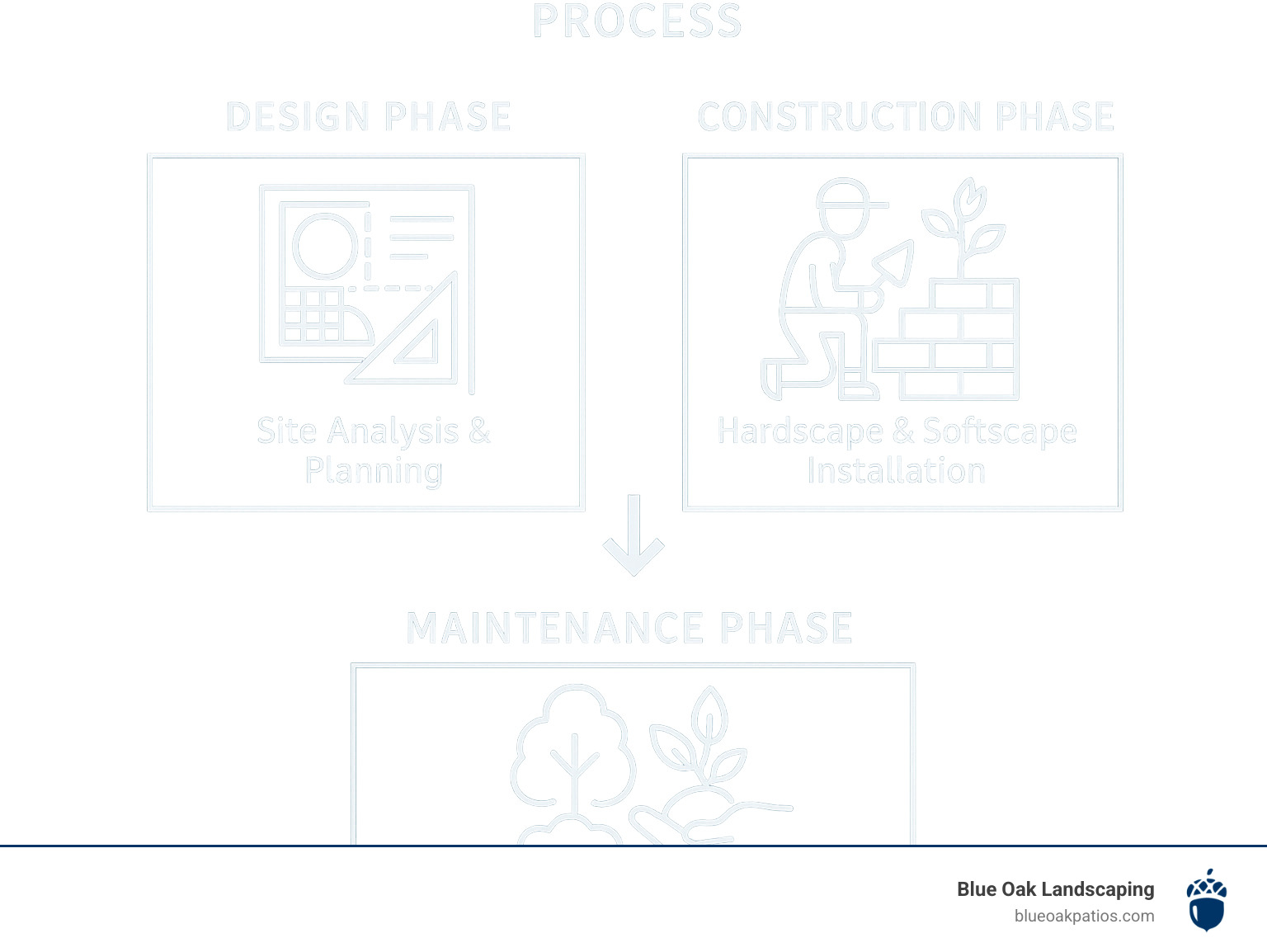
Explore more about landscape design and construction:
– front yard landscape design
– landscape design layout
– landscaping ideas
Why Curb Appeal Starts Underground
The most stunning landscapes begin where you can’t see them – beneath the surface. Proper soil preparation and drainage fundamentals determine whether your investment thrives or fails within the first few seasons.
Healthy root systems require well-draining soil with proper pH levels and adequate organic matter. Before we install a single paver or plant the first tree, we conduct thorough soil analysis to identify compaction issues, drainage problems, and nutrient deficiencies.
Drainage issues cause more landscape failures than any other factor. We address grading, install proper drainage systems, and amend soil before moving to the visible elements of your project.
Understanding Landscape Design and Construction
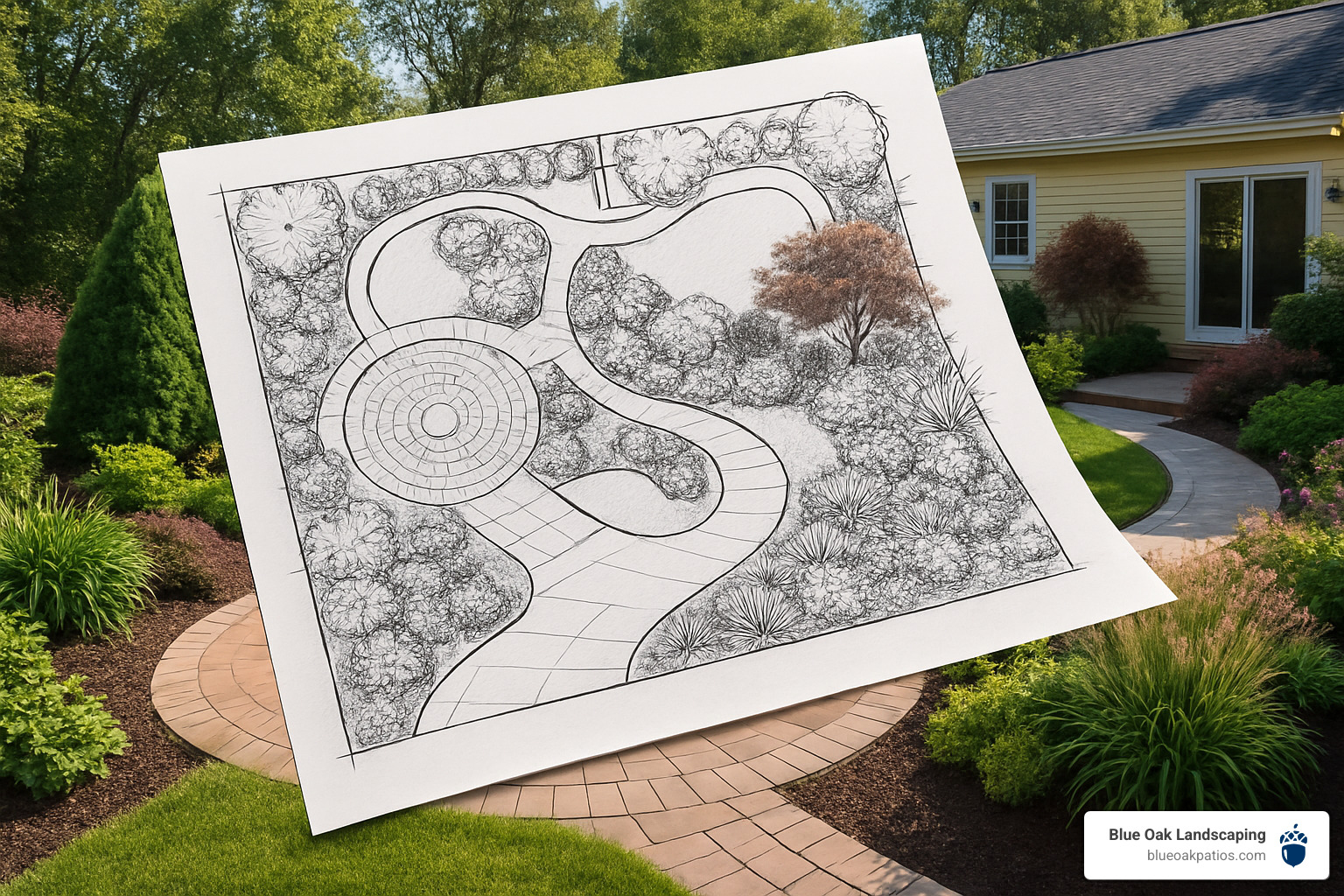
Landscape design and construction is the perfect marriage between an artist’s vision and an engineer’s precision. The magic happens when creative planning meets skilled hands-on work to transform your outdoor space from ordinary to extraordinary.
The design phase is where dreams take shape on paper. We study your property’s unique conditions and create detailed plans that work with your local climate. The construction phase transforms those plans into reality through technical expertise – installing retaining walls that will stand strong for decades, creating patios that drain properly, and placing plants where they’ll thrive.
Landscape architecture is now officially recognized as a STEM field because today’s professionals need to understand everything from soil chemistry to hydrology to engineering principles. We’re creating functional outdoor systems that work with nature, not against it.
At Blue Oak Landscaping, we offer both design and construction services under one roof, ensuring smooth communication and no delays while waiting for different companies to coordinate.
Why Invest in Professional Landscape Design and Construction?
Professional landscape design and construction delivers real benefits beyond having the prettiest yard on the block.
Your property value gets a serious boost from quality landscape work – we’re talking about 15-20% increases in home value. A well-designed outdoor space becomes your lifestyle upgrade, changing unused backyards into morning coffee spots, weekend entertainment hubs, or peaceful retreats.
The stress-free process might be the biggest benefit. We handle permits, coordinate deliveries, manage timelines, and solve problems before they become your headaches. Professional installation means your investment will look great and function properly for decades.
Career Pathways in Landscape Design and Construction
Landscape architects are licensed professionals with four-year degrees who can work on everything from residential gardens to city parks. The Academy of Art University offers programs that prepare students for these roles.
Landscape contractors focus on hands-on construction and installation work. Programs like the one at UC Davis are fully accredited by the American Society of Landscape Architects (ASLA), ensuring graduates meet professional standards.
The industry rewards people who combine creativity with practical problem-solving skills, offering satisfying careers helping people create beautiful, functional outdoor spaces.
Components of a Landscape Project: Hardscape vs. Softscape
Hardscape elements are the non-living components that create structure and functionality – patios, walkways, retaining walls, and fire pits made from materials like concrete pavers, flagstone, clay brick, or porcelain tile. When properly installed, these elements can last 20 to 50 years or more with minimal maintenance.
Softscape elements are the living components that change with the seasons – perennials, shade trees, native species, and ornamental grasses. While they require more ongoing care, they provide seasonal color and environmental benefits that make outdoor spaces truly special.
The magic happens when these elements work together harmoniously. We always recommend starting with hardscape placement during the design phase, then designing softscape to complement these foundations.
For detailed guidance on achieving this balance, check out our comprehensive guide on Hardscaping and Landscape Design.
Selecting the Right Hardscape Materials
Concrete pavers remain our most popular choice, offering incredible versatility in colors, sizes, and textures while providing consistent quality. They’re engineered to resist Ohio’s harsh freeze-thaw cycles and maintain their appearance for decades.
Interlocking pavers take durability to the next level through their engineering. The interlocking design distributes weight evenly and allows for slight movement without cracking, making them perfect for driveways or high-traffic areas.
Permeable pavers offer an excellent solution for managing stormwater runoff while looking just as attractive as traditional pavers.
For something special, bluestone and flagstone create one-of-a-kind installations. Each piece has unique character and can literally last centuries when properly installed.
Clay brick brings classic charm that works beautifully with traditional architecture and handles Ohio winters exceptionally well.
Porcelain tile provides extremely low maintenance when properly installed on concrete substrates, though it requires experienced installation.
We never recommend painting or staining pavers – these treatments typically fail within a few years. Quality materials in their natural state provide the best long-term value.
Softscape Strategies for Every Season
Perennial plantings form the foundation of smart landscape strategy. We select varieties that bloom at different times from spring through fall, ensuring you always have something beautiful happening.
Shade trees provide immediate impact and long-term benefits, reducing cooling costs by up to 30% while adding significant property value.
Pollinator gardens support local ecosystems while providing stunning displays. Native wildflowers and flowering shrubs attract beneficial insects and birds while requiring minimal inputs once established.
Drought-tolerant plant palettes thrive during dry periods and require less irrigation, reducing both water bills and maintenance time.
The secret is layering plants with different heights, textures, and bloom times to create year-round visual interest.
Step-by-Step Process: Bringing Your Vision to Life
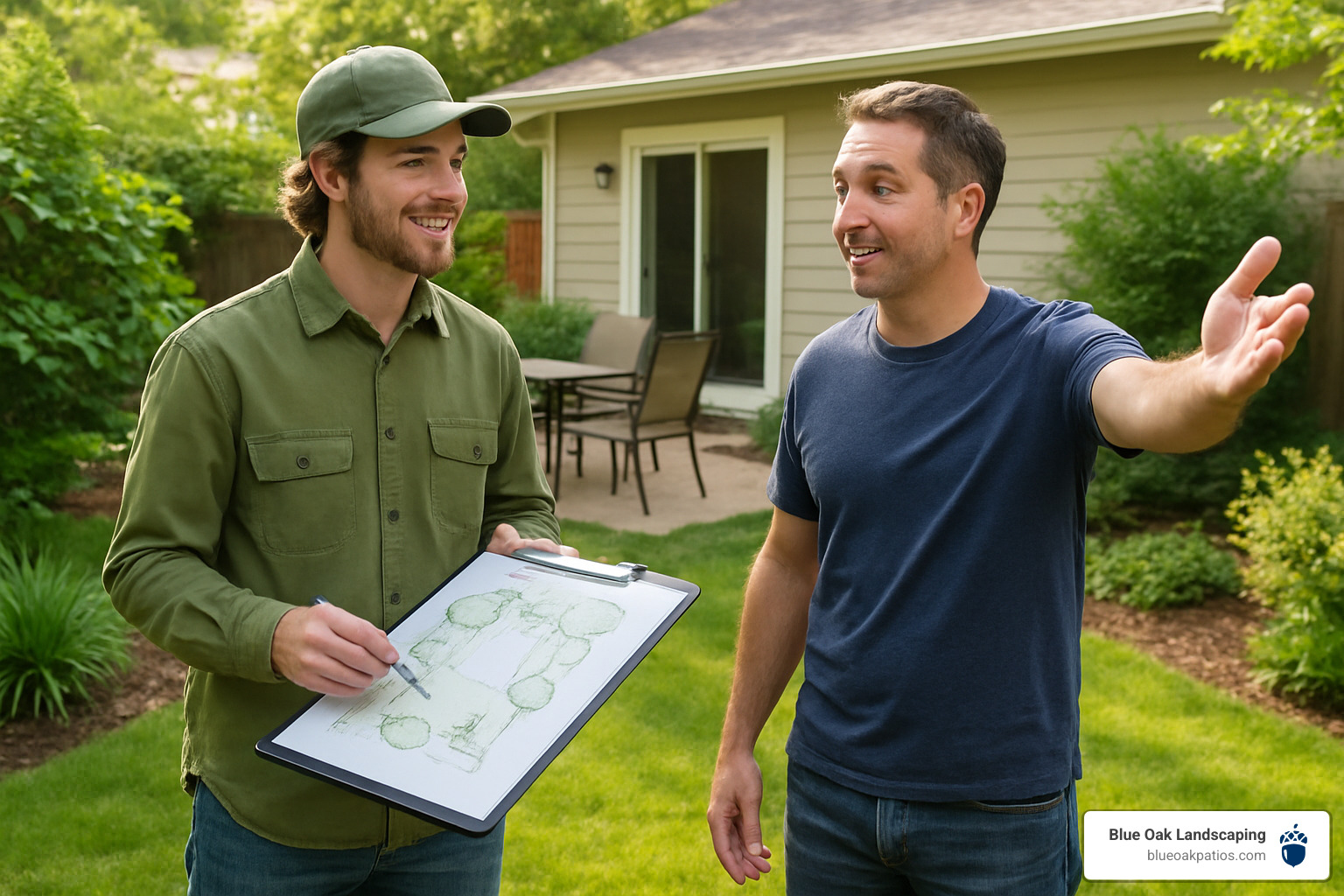
Every successful landscape design and construction project begins with understanding your dreams for the space. We explore your lifestyle needs – whether you want to host summer barbecues, create a quiet retreat, or solve drainage problems.
We walk your property together, identifying opportunities and discussing challenges. Our site analysis evaluates soil conditions, drainage patterns, sun exposure, and existing vegetation. This assessment helps us avoid costly surprises and ensures every element will thrive.
Using AutoCAD and 3D modeling software, we create detailed plans showing exactly how your finished project will look. Budget discussions happen throughout our design process with transparent communication about costs and timelines.
When permits are required, we handle all paperwork and coordinate with local authorities.
For detailed planning insights, explore our Landscape Design Layout resource.
Landscape Design and Construction Timeline
The concept phase typically takes one to two weeks, where we present initial design ideas and gather feedback.
Design development follows with another one to two weeks of detailed planning, specifying exact materials and creating construction details.
Our pre-construction phase handles permits, material ordering, and crew scheduling.
The construction phase takes two to six weeks depending on complexity. We start with hardscape elements, then move to softscape installation.
Final inspection takes about a week, including walkthrough and maintenance instructions.
Seasonal considerations significantly impact scheduling – we avoid extreme temperatures or wet conditions that could compromise quality.
Landscape Design and Construction in Action: Case Studies
One recent Hilliard project involved a sloping backyard that seemed unusable. We created a multi-level entertainment space with flagstone patios, integrated fire pit areas, and retaining walls that double as seating. The clients now spend more time in their backyard than their living room during good weather.
Another project tackled drainage problems and poor curb appeal by installing permeable pavers in the driveway and creating an attractive natural stone walkway with thoughtfully designed entrance plantings.
A recent backyard renovation showcased how hardscape and softscape elements work together, combining concrete paver patios with an integrated outdoor kitchen and water feature, creating distinct zones while maintaining visual harmony.
Sustainable Trends, Innovations, and Challenges
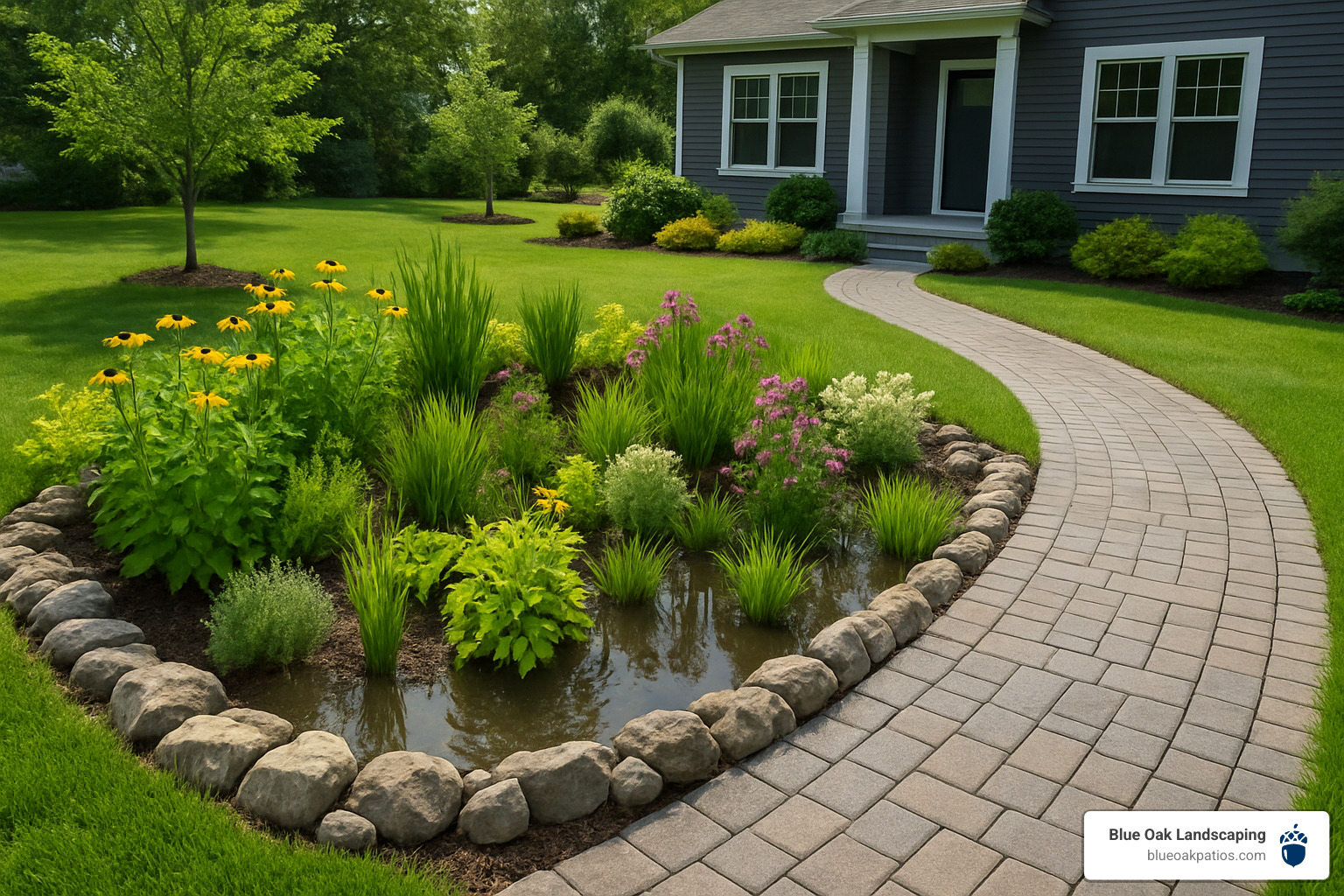
The future of landscape design and construction emphasizes environmental responsibility alongside beauty. Today’s homeowners want outdoor spaces that look stunning while being kind to the environment – and sustainable landscaping often saves money long-term.
Climate adaptation has become essential in Ohio’s unpredictable weather. Rain gardens capture stormwater runoff while creating attractive focal points. Permeable pavers let water soak through instead of rushing toward storm drains.
Native plant communities thrive without constant watering or fertilizing because they’re adapted to Ohio’s conditions. They support pollinator gardens that bring butterflies and hummingbirds to your yard.
Smart irrigation systems check weather forecasts and soil moisture levels, adjusting automatically. LED lighting systems illuminate landscapes while barely touching electric bills. Recycled materials in hardscape construction perform just as well while reducing environmental impact.
For insights on sustainable practices, explore the UC Davis Landscape Architecture program, which emphasizes environmental stewardship.
Overcoming Site-Specific Challenges
Every property has unique challenges that become opportunities for creative solutions. Soil amendment forms the foundation – we test soil first and address drainage, compaction, and nutrient issues.
Grading solutions solve water problems while creating visual interest. Drainage systems work behind the scenes with underground piping and catch basins to prevent water damage.
Microclimate management addresses how your front yard might be completely different from your backyard, matching plants to their ideal locations.
Tech and Tools Shaping Landscape Design and Construction
Drone surveys give us aerial views revealing drainage patterns and measuring areas accurately. CAD and 3D modeling software creates detailed construction documents and realistic visualizations.
Virtual reality walkthroughs let you experience your future landscape before construction begins. Automated equipment improves installation precision with GPS-guided excavators and laser-leveled screeds.
Project management software keeps everyone informed with real-time updates and progress photos, ensuring transparency throughout construction.
Preparing, Maintaining & Maximizing Value
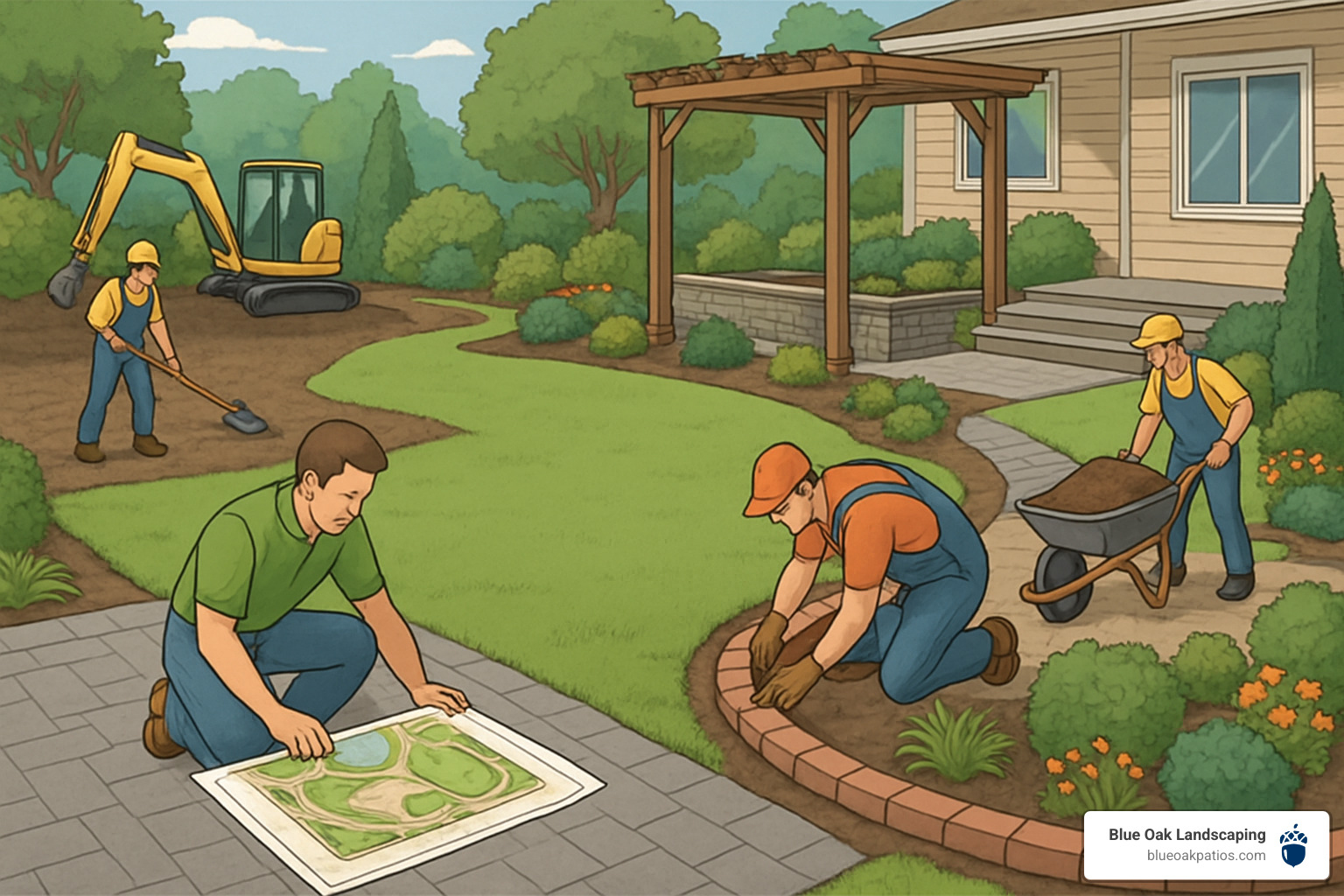
Successful landscape design and construction starts with thoughtful preparation and realistic maintenance planning. Quality materials and professional installation require larger upfront investment but deliver better long-term value through reduced maintenance and longer lifespan.
Vision development works best when you’ve done homework – browse inspiration photos, visit demonstration gardens, and think about how you’ll use your space. Timeline considerations matter – starting design during winter allows for optimal spring construction.
For guidance on team selection, check our resource on Finding the Right Landscaping Company for Your Yard. Our A Complete Guide to Patio and Hardscape Installation walks you through the construction process.
Post-Construction Landscape Management
Hardscape maintenance stays simple when done correctly. Concrete pavers need annual cleaning and benefit from sealing every 2-3 years. We never recommend painting or staining pavers – quality materials look best in their natural state.
Plant care schedules vary by species and season. Newly installed plants need frequent attention during their first growing season while roots establish. Irrigation system care prevents costly repairs through annual spring startups and fall winterizations.
Seasonal maintenance includes spring cleanup and fall preparation, making the difference between landscapes that thrive and those that merely survive.
Client Checklist Before Starting Landscape Design and Construction
Define goals clearly – whether you want entertaining space, better curb appeal, or drainage solutions. Establish realistic budgets including ongoing maintenance costs.
Gather inspiration materials to help communicate your vision. Assess timeline honestly considering seasonal factors and personal constraints.
Research professionals thoroughly – interview multiple contractors, check references, and verify licenses. Focus on experience and reputation when making selections.
Understand maintenance requirements for different elements, or budget for professional maintenance services.
Frequently Asked Questions about Landscape Design and Construction
What is the difference between a landscape designer and a landscape architect?
Landscape architects have completed four-year degrees in landscape architecture and often hold professional licenses. They tackle large commercial projects and complex environmental challenges requiring serious engineering expertise.
Landscape designers come from varied backgrounds – many have degrees in horticulture or design, while others built expertise through hands-on experience. They focus primarily on residential projects and excel at creating beautiful, functional spaces for homeowners.
For most residential projects in Hilliard, an experienced landscape designer provides exactly what you need. Experience with your type of project matters more than the specific title.
How long does a typical residential project take from design to completion?
The design phase usually takes 2-4 weeks from first meeting to final plan approval. Construction timelines vary dramatically:
- Simple patios or walkways: 3-5 days
- Comprehensive backyard renovations: 2-4 weeks
- Complete landscape installations: 4-8 weeks or more
Weather plays a huge role in scheduling. Spring and fall offer the best conditions, while summer heat and winter weather may cause delays. We’d rather wait for proper conditions than compromise your investment.
How much should I budget for professional landscape design and construction?
Project costs vary enormously based on space size, desired features, and material selection. Concrete pavers offer excellent value, while natural stone costs more but provides unique character lasting generations.
Site conditions affect costs – properties with drainage issues, steep slopes, or poor soil require additional work. Design fees typically represent 10-15% of total project investment.
Budget planning should include ongoing maintenance costs. Quality materials and professional installation provide better long-term value through reduced maintenance needs and longer lifespan.
The best approach is starting with a consultation where we assess your site and provide realistic budget ranges for achieving your vision.
Conclusion
Your journey through landscape design and construction is just the beginning of creating the outdoor space you’ve always dreamed about. Professional landscape work solves multiple challenges at once – you’re investing in increased property value, more entertaining space, and a peaceful retreat right outside your door.
Sustainability isn’t just a buzzword – it’s smart business. When we choose native plants that thrive without constant watering or install permeable pavers that handle Ohio’s unpredictable weather, we’re setting you up for long-term success with less work and better performance.
The biggest difference in any landscape project is working with a team that handles both design and construction. When the same people who design your outdoor kitchen install the concrete pavers, nothing gets lost in translation. No delays, no miscommunication, and no surprises.
After 25 years of changing outdoor spaces throughout Hilliard, Bexley, and Upper Arlington, we’ve learned that the best projects happen when homeowners come with big dreams and realistic expectations. The secret to success starts with getting clear about what you really want from your outdoor space.
Ready to turn your backyard dreams into reality? We’re here to help you steer every step of the process, from that first site visit to the final walkthrough. Find More info about your dream outdoor space and let’s start planning something amazing together.
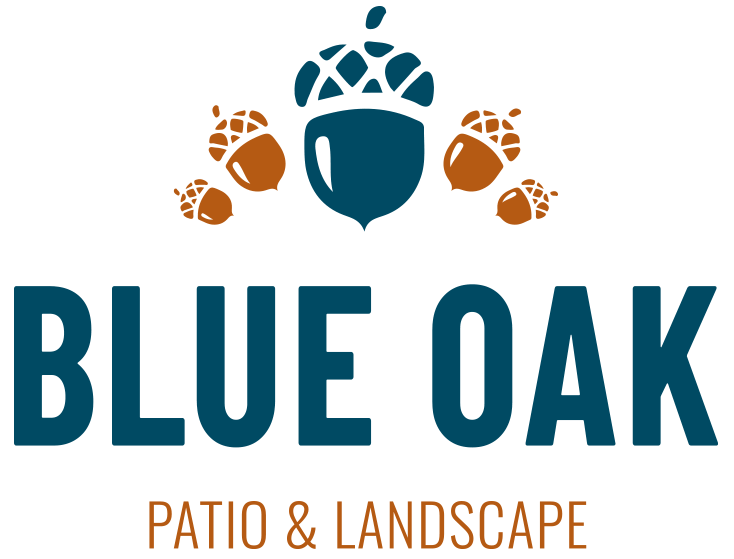
Recent Comments